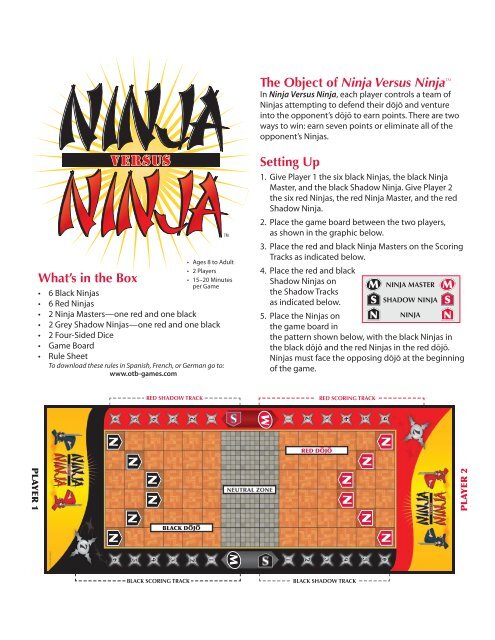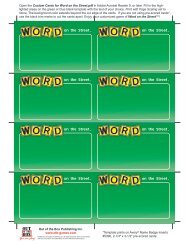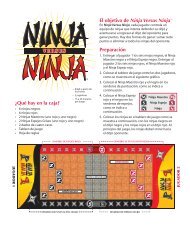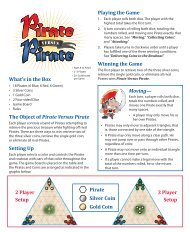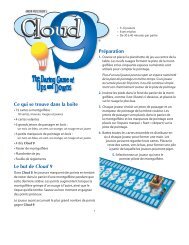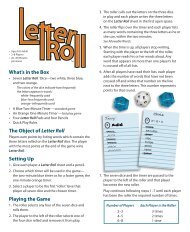Rules - Out of the Box Publishing
Rules - Out of the Box Publishing
Rules - Out of the Box Publishing
Create successful ePaper yourself
Turn your PDF publications into a flip-book with our unique Google optimized e-Paper software.
The Object <strong>of</strong> Ninja Versus Ninja TM<br />
In Ninja Versus Ninja, each player controls a team <strong>of</strong><br />
Ninjas attempting to defend <strong>the</strong>ir dōjō and venture<br />
into <strong>the</strong> opponent’s dōjō to earn points. There are two<br />
ways to win: earn seven points or eliminate all <strong>of</strong> <strong>the</strong><br />
opponent’s Ninjas.<br />
What’s in <strong>the</strong> <strong>Box</strong><br />
• Ages 8 to Adult<br />
• 2 Players<br />
• 15–20 Minutes<br />
per Game<br />
• 6 Black Ninjas<br />
• 6 Red Ninjas<br />
• 2 Ninja Masters—one red and one black<br />
• 2 Grey Shadow Ninjas—one red and one black<br />
• 2 Four-Sided Dice<br />
• Game Board<br />
• Rule Sheet<br />
To download <strong>the</strong>se rules in Spanish, French, or German go to:<br />
www.otb-games.com<br />
TM<br />
Setting Up<br />
1. Give Player 1 <strong>the</strong> six black Ninjas, <strong>the</strong> black Ninja<br />
Master, and <strong>the</strong> black Shadow Ninja. Give Player 2<br />
<strong>the</strong> six red Ninjas, <strong>the</strong> red Ninja Master, and <strong>the</strong> red<br />
Shadow Ninja.<br />
2. Place <strong>the</strong> game board between <strong>the</strong> two players,<br />
as shown in <strong>the</strong> graphic below.<br />
3. Place <strong>the</strong> red and black Ninja Masters on <strong>the</strong> Scoring<br />
Tracks as indicated below.<br />
4. Place <strong>the</strong> red and black<br />
Shadow Ninjas on<br />
<strong>the</strong> Shadow Tracks<br />
as indicated below.<br />
5. Place <strong>the</strong> Ninjas on<br />
<strong>the</strong> game board in<br />
<strong>the</strong> pattern shown below, with <strong>the</strong> black Ninjas in<br />
<strong>the</strong> black dōjō and <strong>the</strong> red Ninjas in <strong>the</strong> red dōjō.<br />
Ninjas must face <strong>the</strong> opposing dōjō at <strong>the</strong> beginning<br />
<strong>of</strong> <strong>the</strong> game.<br />
Red Shadow Track<br />
Red SCORING Track<br />
RED DOJO<br />
PLAYER 1<br />
NEUTRAL ZONE<br />
PLAYER 2<br />
BLACK DOJO<br />
BLACK SCORING Track<br />
BLACK Shadow Track<br />
DL_7007_1Ninja<strong>Rules</strong>.indd 1<br />
5/29/08 8:20:00 PM
Playing <strong>the</strong> Game<br />
Each player rolls both dice and <strong>the</strong> player with <strong>the</strong><br />
highest total takes <strong>the</strong> first turn.<br />
A turn consists <strong>of</strong> rolling both dice, totaling <strong>the</strong><br />
numbers rolled, and moving one Ninja exactly that<br />
many spaces. See Ninja Moves for allowable moves.<br />
• A Ninja will ei<strong>the</strong>r move within <strong>the</strong> home dōjō or<br />
go on a Mission. Any time a Ninja leaves <strong>the</strong> home<br />
dōjō, that Ninja is considered to be on a Mission.<br />
Going on a Mission is <strong>the</strong> only way to earn points.<br />
See Going on a Mission.<br />
• A Ninja may eliminate an opposing Ninja while in<br />
<strong>the</strong> home dōjō or while on a Mission. If a Ninja’s<br />
move ends on a space occupied by an opponent’s<br />
Ninja, <strong>the</strong> opponent’s Ninja is removed from <strong>the</strong><br />
board and remains out <strong>of</strong> play for <strong>the</strong> rest <strong>of</strong> <strong>the</strong><br />
game. No points are scored for eliminating Ninjas.<br />
Players alternate taking turns until one player<br />
has scored seven points or eliminated all <strong>of</strong> <strong>the</strong><br />
opponent’s Ninjas.<br />
Winning <strong>the</strong> Game<br />
The first player to earn seven points, or to eliminate all<br />
<strong>of</strong> <strong>the</strong> opponent’s Ninjas, wins Ninja Versus Ninja.<br />
Ninja Moves<br />
Moves Allowed<br />
• A player may only move his or her own Ninjas.<br />
• Ninjas must move along a clear path. If any space on a path is<br />
blocked by a Ninja, <strong>of</strong> ei<strong>the</strong>r color, that path may not be taken.<br />
• Straight Line and L-Shaped moves, in any direction, are<br />
allowed on any move. An L-Shaped move is a move with one,<br />
and only one, 90° turn, regardless <strong>of</strong> <strong>the</strong> number <strong>of</strong> spaces<br />
moved.<br />
• One Reversal is allowed during <strong>the</strong> three turns while a Ninja is<br />
on a Mission. A Reversal is when a Ninja moves away from <strong>the</strong><br />
home dōjō, and <strong>the</strong>n moves back on <strong>the</strong> same path, toward <strong>the</strong><br />
home dōjō, all in one turn. A Reversal is only allowed inside <strong>the</strong><br />
opponent’s dōjō.<br />
• A Reversal may be combined with an L-Shaped move.<br />
• Moves that end on a square occupied by an opponent’s Ninja<br />
are allowed. The opponent’s Ninja is <strong>the</strong>reby eliminated from<br />
<strong>the</strong> game and removed from <strong>the</strong> board.<br />
Moves Not Allowed<br />
• Diagonal moves<br />
• Moves that require jumping over Ninjas,<br />
<strong>of</strong> ei<strong>the</strong>r color<br />
• Reversals within a player’s home dōjō or<br />
in <strong>the</strong> neutral zone<br />
• Moves that include more than one 90° turn<br />
• Moves that end on a square occupied by a player’s own Ninja<br />
DL_7007_1Ninja<strong>Rules</strong>.indd 2<br />
5/29/08 8:20:02 PM
Going on a Mission<br />
When a Ninja leaves <strong>the</strong> home dōjō, that Ninja begins a Mission.<br />
• A Mission must be completed within a total <strong>of</strong> three consecutive turns.<br />
• Each player may only have one Ninja on a Mission at any one time.<br />
• Ninjas are not required to use all three turns <strong>of</strong> a Mission and may return on<br />
turn two or even turn one.<br />
• While on a Mission a Ninja is not required to enter <strong>the</strong> opponent’s dōjō and<br />
may return having only advanced as far as <strong>the</strong> neutral zone.<br />
• Whenever a Ninja returns to its home dōjō it is rotated to its original orientation<br />
(facing <strong>the</strong> opponent’s home dōjō) and remains in that orientation until it begins a Mission.<br />
• If a player has a Ninja on a Mission, that player may choose to move ano<strong>the</strong>r <strong>of</strong> his or her<br />
Ninjas, but that move still counts as one <strong>of</strong> <strong>the</strong> three turns for <strong>the</strong> Ninja on <strong>the</strong> Mission.<br />
The Three Turns <strong>of</strong> a Mission<br />
After each turn <strong>of</strong> a Mission, <strong>the</strong> Ninja is rotated to indicate how many turns that Ninja has to return to <strong>the</strong> home dōjō.<br />
TURN 1<br />
The turn in which a Ninja leaves <strong>the</strong> home dōjō is <strong>the</strong> first turn <strong>of</strong> a Mission. At <strong>the</strong><br />
end <strong>of</strong> that turn, <strong>the</strong> Ninja is rotated 90° clockwise to indicate that <strong>the</strong> Ninja must<br />
be returned to <strong>the</strong> home dōjō within <strong>the</strong> next two turns <strong>of</strong> that player.<br />
TURN 2<br />
On <strong>the</strong> second turn <strong>of</strong> a Mission, <strong>the</strong> Ninja is rotated an additional 90° clockwise<br />
to indicate that <strong>the</strong> Ninja must be returned to <strong>the</strong> home dōjō on that player’s third<br />
turn. This Ninja is rotated regardless <strong>of</strong> whe<strong>the</strong>r or not <strong>the</strong> player decides to move it.<br />
TURN 3<br />
On <strong>the</strong> third turn <strong>of</strong> a Mission, <strong>the</strong> Ninja must be returned to <strong>the</strong> home dōjō or it is<br />
eliminated from <strong>the</strong> game and removed from <strong>the</strong> board. If <strong>the</strong> Ninja is successfully<br />
returned to <strong>the</strong> home dōjō it is rotated 180° to its original orientation.<br />
Ninja<br />
position<br />
after<br />
turn 1<br />
Ninja<br />
position<br />
after<br />
turn 2<br />
Ninja<br />
position<br />
after<br />
turn 3<br />
Scoring Points<br />
To score points a Ninja must move out <strong>of</strong> it’s home dōjō, across <strong>the</strong> neutral zone, into <strong>the</strong> opponent’s dōjō,<br />
and make it back safely to <strong>the</strong> home dōjō, all within <strong>the</strong> three turns <strong>of</strong> a Mission. The number <strong>of</strong> points<br />
scored depends on how far into <strong>the</strong> opponent’s dōjō <strong>the</strong> Ninja advances.<br />
• The Shadow Ninja is used to indicate <strong>the</strong> number <strong>of</strong> points that could be earned on a Mission. When a<br />
Ninja moves into <strong>the</strong> opponent’s dōjō, <strong>the</strong> Shadow Ninja is moved to <strong>the</strong> number on <strong>the</strong> shadow track<br />
which corresponds to <strong>the</strong> deepest row that <strong>the</strong> Ninja has reached.<br />
• If <strong>the</strong> Ninja on a Mission is eliminated by an opposing Ninja or does not return to <strong>the</strong> home dōjō by <strong>the</strong><br />
third turn <strong>of</strong> that Mission, no points are earned and <strong>the</strong> Ninja is removed from <strong>the</strong> board. The Shadow<br />
Ninja is returned to <strong>the</strong> start <strong>of</strong> <strong>the</strong> Shadow Track.<br />
• If <strong>the</strong> Ninja on a Mission returns home safely, <strong>the</strong> Ninja Master records <strong>the</strong> score by moving <strong>the</strong> number<br />
<strong>of</strong> spaces on <strong>the</strong> scoring track indicated by <strong>the</strong> position <strong>of</strong> <strong>the</strong> Shadow Ninja. The Shadow Ninja is <strong>the</strong>n<br />
returned to <strong>the</strong> start <strong>of</strong> <strong>the</strong> Shadow Track.<br />
DL_7007_1Ninja<strong>Rules</strong>.indd 3<br />
5/29/08 8:20:02 PM
Strategic Hints<br />
Play <strong>the</strong> Odds<br />
The safety <strong>of</strong> any space on <strong>the</strong> board is determined by what <strong>the</strong> o<strong>the</strong>r player must roll<br />
to eliminate your Ninja while it is occupying that space. If your opponent needs to roll<br />
a 2 or an 8 to eliminate your Ninja, <strong>the</strong>n that space is relatively safe. If your piece can be<br />
eliminated with a roll <strong>of</strong> 4, 5, or 6, <strong>the</strong>n that space is quite risky.<br />
Take What You Can Get<br />
If your Ninja is on <strong>the</strong> third turn <strong>of</strong> a Mission and your roll is insufficient to return that Ninja<br />
to your home dōjō, see if you can eliminate one <strong>of</strong> your opponent’s Ninjas. You will lose<br />
your piece ei<strong>the</strong>r way so you might as well benefit from <strong>the</strong> unfortunate situation.<br />
Play Defensively<br />
Sometimes it is advantageous to keep your Ninjas back to protect your dōjō. You cannot<br />
score points with this strategy, but you will be in a better position to eliminate your<br />
opponent’s Ninjas.<br />
Keep Your Friends Close and Your Enemies Closer<br />
In your opponent’s dōjō, if your Ninja is adjacent to an opponent’s Ninja, <strong>the</strong>re is no way for<br />
that Ninja to eliminate your piece (<strong>the</strong> two dice can only roll <strong>the</strong> numbers 2–8). Adjacent<br />
Ninjas may also protect you by blocking <strong>the</strong> path to your Ninja.<br />
Protecting Your Dojo<br />
If your opponent has entered your dōjō and is attempting to get home to score points,<br />
sometimes <strong>the</strong> best course <strong>of</strong> action is to use your own piece to block that Ninja’s exit.<br />
Forcing that Ninja to move one or two extra spaces may be enough to guarantee that it<br />
will not make it back within <strong>the</strong> three turns <strong>of</strong> that Mission.<br />
<strong>Out</strong> <strong>of</strong> <strong>the</strong> <strong>Box</strong> <strong>Publishing</strong> Inc.<br />
609 Bennett Road<br />
Dodgeville, WI 53533<br />
800-540-2304<br />
info@otb-games.com<br />
www.otb-games.com<br />
Original Concept Tushar Gheewala<br />
Game Play Design Team Max Osterhaus, Ellen Winter, Al Waller,<br />
Mark Alan Osterhaus<br />
Illustration and Graphic Design John Kovalic, Cathleen Quinn-Kinney<br />
Production Development Tom Strom, Matt Mariani<br />
©2008 <strong>Out</strong> <strong>of</strong> <strong>the</strong> <strong>Box</strong> <strong>Publishing</strong> Inc. All rights reserved. Ninja Versus Ninja, Award Winning Fun®, and <strong>Out</strong> <strong>of</strong> <strong>the</strong> <strong>Box</strong>® are trademarks <strong>of</strong> <strong>Out</strong> <strong>of</strong> <strong>the</strong> <strong>Box</strong> <strong>Publishing</strong> Inc.<br />
#7007 Printing Number 10 9 8 7 6 5 4 3 2 1<br />
DL_7007_1Ninja<strong>Rules</strong>.indd 4<br />
5/29/08 8:20:03 PM


